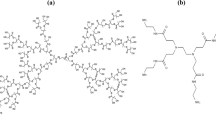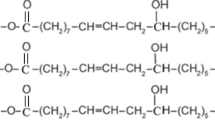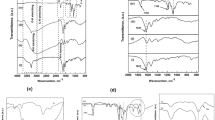Abstract
We developed β-cyclodextrin (CD)/polypropylene (PP) composite nonwoven fabrics (NWFs) via surface modification of PP using the photoactivated chlorine dioxide radical (ClO2•) oxidation method. The hydrophilicity and dyeability of the PP NWFs were improved owing to the immobilization of β-CD. In addition, the prepared β-CD/PP composite NWFs showed sustained drug release for over 12 h in phosphate buffer, indicating that the β-CD supported on PP fibers functioned successfully.
This is a preview of subscription content, access via your institution
Access options
Subscribe to this journal
Receive 12 print issues and online access
$259.00 per year
only $21.58 per issue
Buy this article
- Purchase on Springer Link
- Instant access to full article PDF
Prices may be subject to local taxes which are calculated during checkout



Similar content being viewed by others
References
Nava-Ortíz CAB, Alvarez-Lorenzo C, Bucio E, Concheiro A, Burillo G. Cyclodextrin-functionalized polyethylene and polypropylene as biocompatible materials for diclofenac delivery. Int J Pharm. 2009;382:183–91.
Lee JH, Park SH, Kim SH. Fabrication of bio-based polyurethane nanofibers incorporated with a triclosan/cyclodextrin complex for antibacterial applications. RSC Adv. 2020;10:3450–8.
Canbolat MF, Celebioglu A, Uyar T. Drug delivery system based on cyclodextrin-naproxen inclusion complex incorporated in electrospun polycaprolactone nanofibers. Colloids Surf B. 2014;115:15–21.
Haji A, Mehrizi MK, Sarani M. Surface modification of polypropylene Nonwoven by plasma and β-Cyclodextrin: optimization and cationic dye removal studies. Surf Interfaces. 2021;25:101278.
Thuaut PL, Martel B, Crini G, Maschke U, Coqueret X, Morcellet M. Grafting of cyclodextrins onto polypropylene nonwoven fabrics for the manufacture of reactive filters. I. Synthesis parameters. J Appl Polym Sci. 2000;77:2118–25.
Martel B, Thuaut PL, Crini G, Morcellet M, Naggi AM, Maschke U, et al. Grafting of cyclodextrins onto polypropylene nonwoven fabrics for the manufacture of reactive filters. II. Characterization J Appl Polym Sci. 2000;78:2166–73.
Martel B, Thuaut PL, Bertini S, Crini G, Bacquet M, Torri G, et al. Grafting of cyclodextrins onto polypropylene nonwoven fabrics for the manufacture of reactive filters. III Study of the sorption properties. J Appl Polym Sci. 2002;85:1771–8.
Gawish SM, Matthews SR, Wafa DM, Breidt F, Bourham MA. Atmospheric plasma-aided biocidal finishes for nonwoven polypropylene fabrics. I. Synthesis and characterization. J Appl Polym Sci. 2007;103:1900–10.
Wafa DM, Breidt F, Gawish SM, Matthews SR, Donohue KV, Roe RM, et al. Atmospheric plasma-aided biocidal finishes for nonwoven polypropylene fabrics. II Functionality of synthesized fabrics. J Appl Polym Sci. 2007;103:1911–7.
Ghoul YE, Martel B, Achari AE, Campagne C, Razafimahefa L, Vroman I. Improved dyeability of polypropylene fabrics finished with β-cyclodextrin–citric acid polymer. Polym J. 2010;42:804–11.
Ohkubo K, Hirose K. Light-driven C–H oxygenation of methane into methanol and formic acid by molecular oxygen using a perfluorinated solvent. Angew Chem Int Ed. 2018;57:2126–9.
Ohkubo K, Asahara H, Inoue T. Photochemical C–H oxygenation of side-chain methyl groups in polypropylene with chlorine dioxide. Chem Commun. 2019;55:4723–6.
Jia Y, Chen J, Asahara H, Asoh T, Uyama H. Polymer surface oxidation by light-activated chlorine dioxide radical for metal–plastics adhesion. ACS Appl Polym Mater. 2019;1:3452–8.
Jia Y, Chen J, Asahara H, Hsu Y, Asoh T, Uyama H. Photooxidation of the ABS resin surface for electroless metal plating. Polymer. 2020;200:122592.
Ghalei S, Li J, Douglass M, Garren M, Handa H. Synergistic approach to develop antibacterial electrospun scaffolds using honey and S-nitroso-N-acetyl penicillamine. ACS Biomater Sci Eng. 2021;7:517–26.
Sano S, Kato K, Ikada Y. Introduction of functional groups onto the surface of polyethylene for protein immobilization. Biomaterials. 1993;14:817–22.
Carrazana J, Reija B, Cabrer P, Soufi W, Novo M, Tato J. Complexation of methyl orange with ß-cyclodextrin: detailed analysis and application to quantification of polymer-bound cyclodextrin. Supramol Chem. 2004;16:549–59.
Mehta SK, Bhasin KK, Dham S. Energetically favorable interactions between diclofenac sodium and cyclodextrin molecules in aqueous media. J Colloid Interface Sci. 2008;326:374–81.
Zemljič LF, Plohl O, Vesel A, Luxbacher T, Potrč S. Physicochemical characterization of packaging foils coated by chitosan and polyphenols colloidal formulations. Int J Mol Sci. 2020;21:495.
It is generally known that when the pH of surrounding solution increases, the positive charge on the PEI coated samples was shielded by OH−. The zeta potential of Ox-80-PEI decreases above pH 8.5, which indicates that cationic PEI is coated. Selected examples of zeta potential measurement for PEI coated material, see;
Wei X, Bao X, Wu J, Li C, Shi Y, Chen J, et al. Typical pharmaceutical molecule removal behavior from water by positively and negatively charged composite hollow fiber nanofiltration membranes. RSC Adv. 2018;8:10396–408.
Barick P, Saha BP, Mitra R, Joshi SV. Effect of concentration and molecular weight of polyethylenimine on zeta potential, isoelectric point of nanocrystalline silicon carbide in aqueous and ethanol medium. Ceram Int. 2015;41:4289–93.
Ding L, Zhang X, Wang Y. Study on the behavior of BOPP film treated by corona discharge. Coatings. 2020;10:1195.
Strobel M, Jones V, Lyons CS, Ulsh M, Kushner MJ, Dorai R, et al. A comparison of corona-treated and flame-treated polypropylene films. Plasma Process Polym. 2003;8:61–95.
Szewczyk PK, Ura DP, Metwally S, Knapczyk-Korczak J, Gajek M, Marzec MM, et al. Roughness and fiber fraction dominated wetting of electrospun fiber-based porous meshes. Polymers. 2019;11:34.
Cohen-Arazi N, Domb AJ, Katzhendler J. New biocompatible polyesters derived from α-amino acids: hydrolytic degradation behavior. Polymers. 2010;2:418–39.
Acknowledgements
This work was supported by JSPS KAKENHI Grant JP20K05606 to HA, NEDO (New Energy and Industrial Technology Development Organization) grant 17101509-0 to HA, and JST OPERA (Open Innovation with Enterprises, Research Institute, and Academia) grant JPMJOP1861 to TI.
Author information
Authors and Affiliations
Corresponding author
Ethics declarations
Conflict of interest
The authors declare that they have no conflict of interest.
Additional information
Publisher’s note Springer Nature remains neutral with regard to jurisdictional claims in published maps and institutional affiliations.
Supplementary information
Rights and permissions
Springer Nature or its licensor (e.g. a society or other partner) holds exclusive rights to this article under a publishing agreement with the author(s) or other rightsholder(s); author self-archiving of the accepted manuscript version of this article is solely governed by the terms of such publishing agreement and applicable law.
About this article
Cite this article
Yamamoto, K., Asahara, H., Moriguchi, M. et al. Immobilization of β-cyclodextrin onto polypropylene nonwoven fabric based on photooxidative surface modification. Polym J 55, 599–605 (2023). https://doi.org/10.1038/s41428-022-00751-8
Received:
Revised:
Accepted:
Published:
Issue Date:
DOI: https://doi.org/10.1038/s41428-022-00751-8



